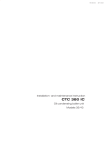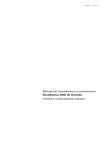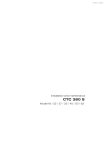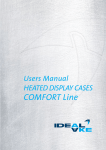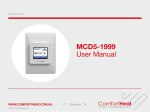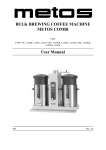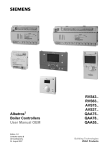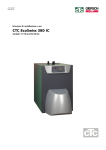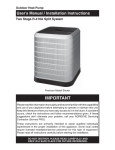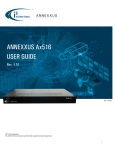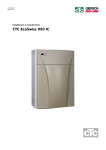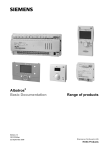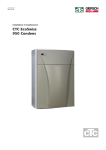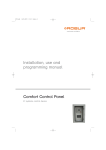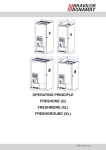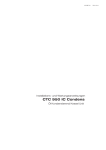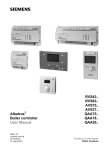Download CTC 380 S
Transcript
161 505 41-4 2015-11-19 Providing sustainable energy solutions worldwide Installation- and maintenance instruction CTC 380 S Model 18 / 22/ 27/ 33 / 40 / 50 / 63 IMPORTANT READ CAREFULLY BEFORE USE KEEP FOR FUTURE REFERENCE 161 505 41-2 2013-01-14 Installation- and maintenance instruction CTC 380 S Model 18 / 22 / 27 / 33 / 40 / 63 For your own reference Fill in the information below. It may be useful if anything should happen Product Manufacturing No. Plumber Name Date Telephone No. Electrician Name Date Telephone No. Chimney sweep Name Date Telephone No. With reservation for typing errors. Subject to alterations in design. General information Table of contents GENERAL INFORMATION 4 3.1 General information.__________________________________________ 18 3.2 Power supply___________________________________________________ 18 3.3 Main switch______________________________________________________ 18 3.4 Heating circuit pump_________________________________________ 18 3.5 Heating circuit mixing valve________________________________ 18 Technical data____________________________________________________7 3.6 DHW charging pump_________________________________________ 18 1.2Measurements____________________________________________________8 3.7 Safety limit thermostat (STB)______________________________ 18 3.8 Electrical diagram 582451/1_______________________________ 19 Welcome________________________________________________________________________ 5 Important to remember!_______________________________________________ 6 Safety Instructions________________________________________________________ 6 General installation conditions____________________________________ 6 1. Technical information____________________________________________ 7 1.1 1.3Description_________________________________________________________9 2.Installation_____________________________________________________________ 10 2.1 2.2 General information___________________________________________ 10 4.1 Before first start________________________________________________ 20 Boiler room______________________________________________________ 10 4.2 First start__________________________________________________________ 20 4.3 After first start___________________________________________________ 20 2.3Transport_________________________________________________________ 10 2.4Unpacking________________________________________________________ 11 5.Operation______________________________________________________________ 21 Boiler stand _____________________________________________________ 11 5.1 General information___________________________________________ 21 2.6 Connection to chimney______________________________________ 12 5.2 Regular inspection____________________________________________ 21 2.7 Flue gas temperatures ______________________________________ 12 5.3Standstill__________________________________________________________ 21 2.8 Hudraulic connection boiler _______________________________ 13 5.4 Frost risk__________________________________________________________ 21 Safety valve boiler_____________________________________________ 13 5.5 Boiler cleaning__________________________________________________ 22 2.10 Heating circuit pump ________________________________________ 14 5.6 Spiro-Condens system cleaning_________________________ 23 2.11 Heating circuit mixing valve _______________________________ 14 5.7Drainage__________________________________________________________ 25 2.12 Connection domestic hot water (DHW) and secon- 5.8 Oil operation_____________________________________________________ 25 5.9 Operations disturbance_____________________________________ 26 2.5 2.9 dary heating circuit ___________________________________________ 14 2.13 DHW charging pump_________________________________________ 14 2.14 System diagrams______________________________________________ 15 2.15 Drainage/Drain valve__________________________________________ 15 2.16Filling_______________________________________________________________ 15 2.17Siphon_____________________________________________________________ 15 2.18 Neutralisation box_____________________________________________ 15 2.19 Chimney solutions_____________________________________________ 16 3. Electrical installation boiler_________________________________ 18 4 4. First start - Commissioning_________________________________ 20 CTC 380 S 6. Comfort control____________________________________________________ 27 General information Welcome Congratulations! You have just bought a CTC 380 S a 3-stroke oil heating boiler for progressive heating, which really corresponds to the present market demands of low energy consumption, comfort and low environmental influence. We hope you will be very pleased with your CTC 380 S and you can read about how to operate your boiler in the following pages. The CTC 380 S is designed to last for many years, and it is here you will find the information you need to operate and maintain the boiler unit correctly and ensure its longevity. • The CTC 380 S has in order to simplify the installation, water- and flue gas connections on the top as well as the rear side of the boiler. • The CTC 380 S is equipped with an adapted, extensional weather-compensated Comfortcontrol which totally fulfils the requirements of a comfortable and energy-saving operation. • The CTC 380 S is thanks to the space-generous burner door and easily accessible combustion surfaces very maintenance-friendly. • The type indication of the boiler is found on the product label on top of the boiler. • The CTC 380 S is designed for firing with a minimum of ecologically harmful emissions and energy losses. • The CTC 380 S is available in seven sizes from 18-63 kW. • The CTC 380 S supplies the total requirement of heating and DHW of the house. CTC 380 S 5 General information Important to remember! Especially check the following points at delivery and installation: • The installation must be carried out by authorized personnel according to existing engineering standards and building regulations. • A correct function of the CTC 380 S, as well as the manufacturer warranty to be valid is only guaranteed when the installation, handling and maintenance are made as by the recommendations in this technical manual. • Operation disturbances and defects which are caused by a not workmanlike handling as well as direct violent handling of the product, liberates the manufacturer from its warranty commitments. • Remove the packaging. Before installation, check that the product has not been damaged during transport. Notify the forwarding agent of any transport damage. • Check that a safety valve drain pipe to the floor drain is being fitted at the installation. • Check the condition of the chimney and secure its durability against condensate. • Please read the chapter about cleaning and maintenance in the end of this manual. • Check the pressure in the expansion vessel annually. • Please, hand over this technical manual to the customer after the installation! Safety Instructions The following safety instructions should be followed when handling, installing and using the CTC 380 S: • Ensure that the boiler is currentless before any interventions. • Do not flush the boiler or any of its control equipment with water. • The flue gas channel and the ventilation duct of the boiler room for air supply must not be blocked. • Check that the burner and its oil tubes are tight. • The operating switch of the boiler must be off if the oil burner is opened and in maintenance position, for example during cleaning or service. • This appliance is not intended for use by persons ( including children) with reduced physical, sensory or mental capabilities, or lack of experience and knowledge, unless they have been given supervision or instruction concerning use of the appliance by a person responsible for their safety. • Children should be supervised to ensure that they do not play with the appliance. General installation conditions A correct function of the CTC 380 S, as well as the manufacturer warranty to be valid is only guaranteed when the installation, handling and maintenance are made as by the recommendations in this technical manual. Operation disturbances and defects which are caused by a not workmanlike handling as well as direct violent handling of the product, liberates the manufacturer from its warranty commitments.Please, hand over this technical manual to the customer after the installation! 6 CTC 380 S ! Regulations: The installation of the boiler and the heating system must be carried out by authorized personnel according to existing engineering standards and building regulations. General information 1. Technical information 1.1 Technical data 3-stroke oil-heating boiler CTC 380 S Model 18 22 27 33 Rated output kW 18,3 22 27,3 33,9 Rated input kW 19,6 23,7 29,2 36,1 Oil supply kg/h 1,65 2,0 2,46 3,05 Flue gas mass flow g/s 8,2 9,9 12,2 14,7 Boiler resistance mbar 0,07 0,10 0,14 0,21 Boiler water resistance ( Δ 20K) mbar 2,0 2,0 3,0 3,0 Flue gas losses * % Radiation losses * %/W Boiler efficiency Flue gas temperature * 5,49 5,19 5,61 5,7 1,11 / 216 1,11 / 216 0,79 / 215 0,6 / 215 % 93,4 93,7 93,6 93,7 °C 138 136 146 160 Boiler efficiency at 70 °C % 93,8 94 94 94,1 Flue gas temperature 70 °C °C 130 128 138 152 Max. Operation pressure boiler (PS) Bar 3 3 3 3 Max. Operation temperature boiler °C 110 110 110 110 Water content l 98,5 98,5 92 92 Weight kg 197 197 200,5 210 Number of turbulators Pcs. Turbulator model Electrical data 6 6 9 9 21/45 27/45 27/45 21/45 230V 1N~ 230V 1N~ 230V 1N~ 230V 1N~ 3-stroke oil-heating boiler CTC 380 S Model 40 50 63 Rated output kW 39,7 51,2 61,6 Rated input kW 42,7 55,1 66,9 Oil supply kg/h 3,6 4,65 5,65 Flue gas mass flow g/s 17,1 23,7 29,7 Boiler resistance mbar 0,4 0,29 0,5 Boiler water resistance ( Δ 20K) mbar 5,0 8,0 9,0 Flue gas losses % 5,7 6,75 7,61 Radiation losses %/W 0,6 / 215 0,45 / 249 Boiler efficiency % 1,11 / 216 Flue gas temperature * °C Boiler efficiency at 70 °C % Flue gas temperature 70 °C °C Max. Operation pressure boiler (PS) Bar Max. Operation temperature boiler °C Water content l Weight kg Number of turbulators Pcs. * According to EN 303-3 Turbulator model Electrical data 230V 1N~ CTC 380 S 7 General information 1.2 Measurements Legend • 6. Drainage R 1” • 1a. Primary flow top R 1”, (18-33)* • 7a. Flue gas outlet top ” 130 mm, (18-33)* • 1b. Primary flow top R 1 ¼”, (40-63)* • 7b. Flue gas outlet top ” 150 mm, (40-63)* • 2a. Return flow top R 1”, (18-33)* • 8. Basic unit Siemens RVS13.143 • 2b. Return flow top R 1 ¼”, (40-63)* • 9a. Operator unit Siemens AVS37.294 • 3a. Primary flow rear R 1”, (18-33)* • 9b. Power pack Siemens AVS16.290 • 3b. Primary flow rear R 1 ¼”, (40-63)* • 10. Adjustable feet M10 • 4a. Return flow rear R 1”, (18-33)* • 11. Flue gas outlet rear • 4b. Return flow rear R 1 ¼”, (40-63)* • 5. Expansion connection R 1” 8 CTC 380 S *) Output-sizes in kW General information 1.3 Description The principle parts of the design consist of measure made steel/stainless steel plates. The boiler has been pressure- and tightness tested and is provided with skin-tight heat insulation as well as powder coated covers plates. Basic unit The basic unit of the Comfort-control – Siemens RVS43.143. For more information, see the part Electrical installation – Comfort-control. Flue gas outlet Connections on the top and rear side. Power pack The power pack of the control panel – Siemens AVS16.290. For more information, see the part Electrical installation – Comfort-control. Ripples The boiler-sizes 33, 40 and 63 kW are equipped with ripples. The ripples enlarge the the surfaces in which the interchange of heat of the second flue gas stroke takes place. This results in an optimized heat transfer of the flue gases to the boiler water. Operator unit The operator unit of the Comfort-control – Siemens AVS37.294. For more information, see the part Electrical installation – Comfort-control. Hinged arm The cleaning door is equipped with hinges which serves as a hinged arm. In that way is it easier to swing out the burner in connection to inspections and maintenance. Burner hood The burner hood is an integrated and sophisticated component part of the boiler. Cleaning door Thanks to the large cleaning door are the turbulators within easy reach as well as it facilitates the simultaneously cleaning and maintenance of the heating surfaces of the boiler. Turbulators The function of the turbulators is to create turbulence of the flue gases, in order to improve the amount of thermal energy which is transmitted to the boiler water. All sizes are from factory, equipped with for each size adapted standard turbulators. The turbulators are reached behind the cleaning door in the front of the boiler. Heat insulation In order to minimize the heat losses the boiler is provided with solid, skin-tight heat insulation. Combustion chamber The generous sized combustion chamber offers the adjusted Low NOx oil burner optimal performance. Adjustable feet The boiler is equipped with four adjustable feet. DUO-Temperature System The combustion chamber is surrounded by two mantles, which allows lowtemperature operation protected from dew-point corrosion resulting in a longlife operation. CTC 380 S 9 General information 2. Installation 2.1 General information The installation must be carried out by authorized personnel according to existing engineering standards and building regulations. The boiler must be connected to an expansion vessel in an open (the expansion vessel of high placement together with safety- and return pipe) or a closed system. At an open system the distance between the expansion vessel and the highest placed radiator must not be less than 2,5 m to avoid oxygen-enrichment of the system. 2.2 Boiler room The boiler room must correspond to existing building regulations and particularly then the firing regulations of the present country. The boiler room must be equipped with a venthole for air supply. The cross section area of the venthole must be at least 6,5 cm2 pro 1 kW boiler output. 2.3 Transport To avoid transport damage, do not unpack the boiler until it has been transported to its site in the boiler room. The boiler can be handled and lifted in the following way: • Forklift • Lift band round the pallet. Note! Only with the packing on. • Sack barrow • By putting carrier pipes in the water connections on the rear side, respectively the build-in 1” carrier sockets on the front side of the boiler 10 CTC 380 S ! Check the pressure in the expansion vessel annually. General information 2.4 Unpacking To avoid damage in the handling, do not unpack the boiler until it has reached its site in the boiler room. After the unpacking check, that the boiler has not been damaged during transport. Report eventual transport damages to the transporter. Standard delivery: • Oil-condensing boiler CTC 950 IC Condens • Safety valve • Siphon • Primary flow sensor • Outdoor sensorDHW storage tank sensor 2.5 Boiler stand (Accessory kit) The boiler stand is delivered as accessory kit. The boiler stand contain following parts: 1. Long sides (2x) 2. Short sides (2x) 3. Adjustable feet (4x) (Not in the accessory kit. Use the adjustable feet of the boiler!) 4. M6-Screws (12x) In order to decrease the lift weight of the boiler, remove the burner and cleaning door during the wall mounting. The boiler stand may be assembled according to following items: 1. Screw the long- and short sides together by using M6-Screws (8x). 2. Fasten the adjustable feet on the underside of the boiler stand. 3. Fasten M6-Screws (4x) from below on the upper side of the boiler stand. 4. Place the boiler on the boiler stand by using the M6-Screws in item 3. as guide pins. Do not fasten! ! Continue the heating boiler installation with the hydralic-, chimney- and electrical work. CTC 380 S 11 General information 2.6 Connection to chimney Existing regulations for the design of the chimney must be taken into consideration. An optimal utilization of the flue gases and with that an energy-saving operation, requires hereby a mostly optimized adaption between boiler and burner. The most important conditions are the following: • Good thermal insulation in order to as much as possible avoid temperature losses from the connection between the boiler and chimney. • Accurate sealing of the flue gas connections • Smooth surfaces of the combustion chamber to avoid turbulence. • Heat-shock resistance as well as water- and steamtight. According to regulations: • The boiler must be connected to the chimney with the shortest feasible flue duct at an angle of 30-45°. • The flue duct must not be fully inserted through the chimney wall. • If flue ducts with a cross-sectional dimension which deviate from the dimension of the flue gas outlet would be used, the connection must be cone-shaped. Cone angle of maximum 7,5°. • By the construction of the flue duct between boiler and chimney must feasible actions be taken to secure that no condensate can flow back to the boiler (condensate trap). 2.7 Flue gas temperatures When a new boiler is being connected to an old chimney, the chimney is often not dimensioned to the new high efficiency of the boiler, which may easily result in condensation in the chimney depending on lower flue gas temperatures. In order to ventilate the chimney with warmer boiler room air, a draught interrupter can be mounted. All boiler-sizes of the CTC 380 Ecoswiss serie has for the current output-size design related operational flue gas temperatures. For flue gas temperature data, see Technical information. 2.8 Hydraulic connection boiler The dimensioning and plumbing of the system shall be accomplished according to the measurements in the part Technical information. 2.9 Safety valve boiler In a closed system, an approved safety valve according to existing regulations must be mounted. The max. Operation pressure of the boiler is 3 bars. The connection pipebetween boiler and safety valve must be constructed in such way that no pressure increase is possible. The safety valve drain pipe must be uncovered and visible. Possible exhausting high-temperature hot water must without danger be removed (Caution! Risk of scalding) 12 CTC 380 S General information 2.10 Heating circuit pump A heating circuit pump must be mounted on the primary flow of the boiler. The pump is being supplied with electric current from the boiler. For more information concerning system principles and connections, see ElectricalL Installation – Comfort-Control. 2.11 Heating circuit mixing valve A heating circuit mixing valve must be mounted on the primary flow of the boiler. The heating circuit mixing valve is being supplied with electric current from the boiler. For more information concerning system principles and connections, see Electrical installation – Comfort-Control. 2.12 Connection domestic hot water (DHW) Secondary heating circuit The connections located on the rear side of the boiler makes it possible to connect the boiler to a secondary heating circuit. These connections offer also the possibility to connect the boiler to a water heater system. The temperature of the return flow to the boiler must not be lower than 45°C. 2.13 Drainage/Drain valve Shall be mounted on the drainage connection on the rear side of the boiler. 2.14 Connection water heater If the CTC 380 S will be combined together with a water heater, is it of high importance that it’s size and power capacity corresponds to the installed boiler output. The installation must correspond to existing building regulations. Recommended to connect on the rear primary- and return flow of the boiler. For more information concerning system principles and connections, see Electrical installation – Comfort-Control. ! If the size of the system exceeds the limits according to the diagram, the volume of the expansion vessel must increase. CTC 380 S 13 General information 3. Electrical installation boiler 3.1 General information. The installation and wiring of the boiler must be carried out by an authorized electrician and in accordance with valid regulations. The internal boiler wiring is from factory prepared for the installation. 3.2 Power supply The boiler should be connected to 230V 1N~ and protective earth. 3.3 Main switch A main switch should be installed. 3.4 Heating circuit pump The heating circuit pump for the heating system is being connected to the connection terminal on the basic unit. The switch for the pump is placed on the comfort-control of the boiler. 3.5 Heating circuit mixing valve The heating circuit mixing valve for the heating system is being connected to the connection terminal on the basic unit. 3.6 Safety limit thermostat (STB) If the boiler has been stored extremely cold the safety limit thermostat may have released. Reset by pressing the button on the power section. Reset button STB 14 CTC 380 S General information 3.7 Electrical diagram E-582450 Si S1 STB H1 Fuse 6,3AT Mains switch with green glow lamp Safety limit thermostat (STB) 110°C Signal lamp (SLT tripped) CTC 380 S 15 General information 4. First start - Commissioning 4.1 Before first start Check that: • The boiler and heating system are filled with water. • All connections are tight and that the chimney connection is made in an correct way. • The oil tank is inspected according to existing regulations. • An oil filter (type Tigerloop) is fitted to the burner. • The electrical connections are made in an correct way. • All sensors, burner, mixing valve and pumps are connected to the power supply. 4.2 First start • Switch on the current with the mains switch. • By commissioning applies the Comfort-control the factory pre-set standard values for set points, time program and operating modes. Though is it prerequisite to make settings of the time of the day and date. Further adjustments for personal requirements are performed according to the technical manual of the Comfort-control. (See also the part Electrical installation – Comfort-control.) • Check that the oil burner starts. • When the boiler has reached its operating temperature, check and adjust the oil burner in accordance with its technical manual. (See also the part Oil burner.) 4.3 After first start Check that: • All pipe connections are tight, tighten if necessary. • The flue duct is tight and well insulated. • The boiler temperature rises upon first start. • Heat goes out to the heating system • The heating circuit pump is running and can be controlled from the Comfort-control of the boiler. • The tapping points of the house are provided with hot water as the boiler has turned warm. • The function of the safety valve is faultless. • The boiler and the heating system are well vented. Re-check after a few days. 16 CTC 380 S General information 5. Operation 5.1 General information After the installation check together with the installer that the installation is fully ready for operation. Let the installer show you all important regulation devices, etc. so that you are well aware of how the boiler installation functions and should be maintained. Vent the radiators after app. 3 days of operation and fill up with more water if necessary. 5.2 Regular inspection The regular inspection should include following items: • Check control of the pressure gauge (manometer). By too low pressure, fill-up water in the heating system by means of charging- and drainage device. • Check control of the heating oil level in the tank. • Check control of the settings of the Comfort-control. • Check control of the temperature of the heating boiler, primary flow and flue gas. • Check control of the burner according to the instructions manual for the burner • In a closed system, check control of the safety valve by means of turning the regulation device of the valve. Check if water run out from the safety valve drain pipe. • Neutralisationbox: Check its function and pH-value according to its manual and existing regulations. 5.3 Standstill If the installation should be put out of operation, use the mains switch. (See the part Electrical installation – Comfort-control.) 5.4 Frost risk Never put the boiler in operation if its pose a risk that the boiler or parts of the heating system is frozen. This leads to damages on the boiler and piping in the house. Consult your heating technician for advice. Concerning protection mode. (See the part Electrical installation – Comfort-control.) CTC 380 S 17 General information 161 505 95 6. Comfort-control 6. Comfort control Comfort-control 6.1 General information General information Theboiler boilerisisfactory factory equipped with Comfort-control Siemens Albatros2. The equipped with thethe Comfort-control Siemens Albatros2. TheComfort-control Comfort-control consists a basic unit, power pack operator The consists of of a basic unit, power pack andand operator unit. unit. The power pack and operator unit creates together the control panel of the boiler. The power pack and operator unit creates together the control panel of the Part 6. describes the principal information the Comfort-control. more information boiler. Part 6. describes the concerning principal information concerning theFore Comfortconcerning functions, programming, system principles etc., please see the Albatros2 control. Fore more information concerning functions, programming, system BoilerGeneral Controller information User Manual. 6.1 principles etc., please see the Albatros2 Boiler Controller User Manual. The boiler is factory equipped with the Comfort-control Siemens Albatros2. Basic unit RVS43.143 The Comfort-control consists of a basic unit, power pack and operator unit. The power pack operatorunit unit creates together the control panel of the boiler. Part 6. describes 6.2and Basic RVS43.143 the principal information concerning the Comfort-control. Fore more information concerning functions, programming, system principles etc., please see the Albatros2 Boiler Controller User Manual. 6. Comfort-control 6.2 Basic unit RVS43.143 6.2.1 Terminal markings N L L N L1 S3 L1 N T1 T2 4 S3 P SK1 SK2 Q N N N Y1 R Q3 S Q2 T Y2 N QX1 U Terminal markings 6.2.1 Terminal markings L N L1 S3 L1 N T1 T2 S3 4 SK2 B3 N L P SK1 N Q M R Q3 N N Y1 S Q2 T Y2 N QX1 U 050110A 000020 RVS43.143/109 S050110000020 1PRVS13.143/109 050110A 000020 RVS43.143/109 2354Z08 S050110000020 n k h f b b BSB X30 X60 X50 DB BSB X30 X60 X50 a DB MB MB CL+ CL- CL+ b CL+ CL- CL+ CL- G+ b - B2 M - - f CL- G+ - B2 M - - B9 M B9 h B3 M H1 k M H1 M p n B1 n M M p B1 M BX1 n M n BX2 M n M BX1 BX2 M 2354Z08 1PRVS13.143/109 CTC 380 IC a CTC 380 IC 18 CTC 380 S 19 19 General information Mains voltage Use Termininal Type of connector Phase AC 230 V basic unit Protective earth Neutral conductor Phase AC 230 V burner Output burner fault N AGP4S.05A/109 P AGP8S.07A/109 N T1 T2 S3 4 Phase burner Protective earth Neutral conductor Phase 1 st burner stage 1 st burner stage on Input burner fault Input burner stage 1 hours run SK1 SK2 Safety loop Safety loop Q AGP8S.02E/109 N Neutral conductor Protective earth DHW charging pump / diverting valve R AGP8S.03A/109 Neutral conductor Protective earth 1st heating circuit pump S AGP8S.03B/109 1st heating circuit mixing valve opening Neutral conductor Protective earth 1st heating circuit mixing valve closing T AGP8S.04B/109 Neutral conductor Protective earth 1st multifunctional output U AGP8S.03C/109 L N L1 S3 L1 Q3 N Q2 Y1 N Y2 N QX1 L CTC 380 S 19 General information Low voltage Use Steckplatz Type of connector BSB LPB X60 X50 X30 Service tool OCI700 Local process bus Radio module AVS71.390 Extension module AVS75.390 Operator unit / boiler control - AVS82.490/109 AVS82.491/109 DB MB LPB data LPB ground a AGP4S.02H/109 CL+ CL- Room unit 2 data Room unit 2 ground b AGP4S.02A/109 CL+ CL- Room unit 1 data Room unit 1 ground b AGP4S.02A/109 AGP4S.03D/109 G+ Room unit power supply 12V B2 M Boiler sensor Ground f AGP4S.02B/109 B3 M DHW sensor top Ground h AGP4S.02C/109 B9 M Outdoor sensor Ground k AGP4S.02D/109 H1 M Digital-/0..10V input Ground n AGP4S.02F/109 B1 M Flow sensor Ground p AGP4S.02G/109 BX1 M Multifunctional sensor input 1 Ground n AGP4S.02F/109 BX2 M Multifunctional sensor input 2 Ground n AGP4S.02F/109 Checking the LED LED off: No power supply LED on: Ready to operate LED flashes: Local faults LED 2358Z33 LPB 20 CTC 380 S General information Power pack AVS16.290 Terminal Name L N Phase AC 230 V brown Protective earth green + yellow Neutral conductor blue Connection to basic unit Terminal Name 1 L 2 Phase AC 230 V basic unit brown Protective earth green + yellow N Neutral conductor blue 4 L1 Phase AC 230 V burner black 5 S3 Input burner fault - 3B 1A 4B 2A S1 1A 2358A16 3 H1 3B1 1 1 Si C 2 STB 2 PE L L Si Si S1S1 STB STB H1H1 N Netzzuleitung Fuse 6,3AT Sicherung 6,3AT Mains switch with green Glimmlampe glow lamp Netzschalter mit grüner Schutztemperaturbegrenzer 110°C Safety limit thermostat (SLT) 110°C Signalleuchte ‚STB verriegelt Signal lamp (STB tripped) N1 L1 S3 1 2 3 4 5 zu Grundgerät RVS… CTC 380 S 21 General information 6.4 Operator unit AVS37.294 Selection DHW mode Selection heating mode Information 2359Z62 Confirmation of setting Quitting the setting Chimney sweep function STB test Manual control Adjustment of room Comfort setpoint Navigation and settings Display choices Heating to the Comfort setpoint Info level activated Heating to the Reducted setpoint Programming activated Heating to the frost protection setpoint Heating function temporarily off ECO function activ Process running - please wait Holiday function active Change battery Reference to heating circuit Burner in operation (only oil/gas burner) Maintenance / special mode Error messages 22 CTC 380 S General information Change Language • Press the ”OK-button” • Press the ”i-button” for 3 seconds, the text ”Endbenutzer” shall be visible. • Select “Endbenutzer” and press “OK”. • Select “Bedieneinheit” and press “OK”. “Bedieneinheit sprache” shall be visible. • Press OK and select language and press “OK”. • Press “ESC” and “ESC” again. Indication Display showing all availiable segments Xxxxxxxxxxxxxxxxxxxxxxxxxxx Xxxxxxxxxxxxxxxxxxxxxxxxxxx Xxxxxxxxxxxxxxxxxxxxxxxxxxx Selecting heating mode Press the button to switch between the different operating modes. The choice made is indicated by a bar which appears below the symbols. Automatic mode Automatic mode controls the room temperature according to the time program. Characteristics of automatic mode: • Heating mode according to the time program • Temperature setpoints according to heating program “Comfort setpoint“ or “Reduced setpoint“ • Protective functions active • Automatic summer / winter changeover (ECO functions) Continous operation or Continous operation maintains the room temperature at the selected operating level. Heating to the Comfort setpoint Heating to the Reduced setpoint Characteristics of continous operation: • Heating mode with no time program • Protective functions active • Automatic summer / winter changeover (ECO functions) and 24-hour heating limit inactive in the case of continuous operation with Comfort setpoint CTC 380 S 23 General information Protection When using Protection, the heating system is off. But it remains protected against frost (frost protection temperature), provided there is no power failure. Eigenschaften des Schutzbetriebs: • Heating off • Temperature according to frost protection • Protective functions active • Automatic summer / winter changeover (ECO functions) and automatic 24-hour heating limit active Selecting DHW heating mode The button is used to switch DHW heating mode on and off. The choice is indicated by a bar which appears below the symbol.. Trinkwasserbetrieb • On The DHW is heated according to the selected switching program. • Off No DHW heating, the protective function is active. Trinkwasser-Push To do this, keep the DHW operating mode button depressed for at least 3 seconds. The DHW push can also be started when: • The operating mode is “Off“ • Operating mode changeover acts via H1 or centrally (LPB) • All heating circuits have assumed the holiday mode Adjusting the room temperature setpoint Turn the setting knob to increase or decrease the Comfort setpoint. For the Reduced setpoint • Press the OK button • Choose operating page ”Heating circuit” and • Adjust the ”Reduced setpoint”. Each time you make a readjustment, wait at least 2 hours, allowing the room temperature to adapt. 24 CTC 380 S General information Displaying information AUTO The button is used to display information. Possible displays Depending on the type of unit, unit configuration and operating state, some of the info lines listed below may not appear. Room temperature Raumtemperatur 4 0 8 12 16 20 24 Displays • Possible error messages from the error code list. • Possible maintenance alarms from the maintenance code list. • Possible special mode messages Other displays: − Room temperature − Outside temperature min − State DHW − Date and time of day − Room temperature minimum − Outside temperature max − State boiler − Telephone customer service − Room temperature maximum − DHW temperature 1 − Boiler temperature − State heating circuit 1 − Outside temperature − State heating circuit 2 Exceptional cases In exceptional cases, the display shows one of the following symbols: AUTO Error messages If this symbol appears, a plant fault has occured. In this case, press the Info button to obtain more information. Fehler Error 30:Vorlauffühler 1 30:Flow Text3 sensor 1 0 4 8 Maintenance or special mode If this symbol appears, a maintenance alarm is delivered or the plant has changed to special mode. In this case, press the Info button to obtain more information. 12 Text4 16 20 24 AUTO Maintenance Wartung 3:Maintenance interval 3:Wartungsintervall Text3 0 4 8 12 16 Text4 20 24 CTC 380 S 25 General information Reset function The reset function for meters and the reset table parameters appears on the bottom line of the display, provided a reset is permitted on the current operating line (enduser / commissioning / heating engineer). After activation with the OK button, the display shows a flashing “Yes“. After confirmation with the OK button, the relevant parameter or meters will be reset. Manual control When manual control is active, the relays are no longer energized and deenergized according to the control state, but are set to a predefined manual operating state depending on their function. The burner relay energized in manual control can be deenergized by the electronic temperature controller (TR). Setpoint adjustment with manual control After manual control has been activated, a change to the basic display must be made. There, the maintenance / special mode symbol appears. Setpoint adjustment with manual control Press the Info button to switch to info display “Manual mode“, where the setpoint can be adjusted. Chimney sweep function The chimney sweep function is activated by a short press (maximum 3 seconds) on the chimney sweep button. It produces the operating state required for making flue gas measurements. STB test The STB test (STB = safety limit thermostat) is activated by a long press (longer than 3 seconds) on the chimney sweep button. The button must be kept depressed during the entire test. If released, the test will be aborted. The STB test is shown on the display. The test must be made by qualified staff since the boiler temperature will be raised above the maximum limitations. 26 CTC 380 S General information Programming Setting principle Settings that cannot be made directly with the help of operating elements are made through programming. For this purpose, the individual settings are structured in the form of operating pages and operating lines, thus forming practical groups of settings. The following example which shows the setting of the time of day and date shall explain this. Example “Setting the time of day“ • When pressing the ESC button, you go back one step; adjusted values will not be adopted • If no setting is made for 8 minutes, the unit will automatically return to the basic display • Operating lines may be hidden, depending on the type of unit, their configuration and user level Operation Display example 1 Description You see the basic display. If the basic display is not shown, press the ESC button to return to it. AUTO 2359Z140 Room temperature 0 4 8 12 2 AUTO 2 AUTO 16 20 24 Press the OK button. The bottom section of the display shows a number of operating pages. Turn the setting knob until operating page “Time of day and date“ appears. 2359Z140 Time of day and date Text3 section Operator 4 8 12 16 20 24 0 4 8 12 16 20 24 2359Z140 0 Time of day and date Text3 section Operator To confirm, press the OK button. 3 AUTO 3 AUTO In the bottom section of the display, the first operating line of operating page “Time of day and date“ appears. 20 24 2359Z140 Hours / minutes Time of day8 and12date16 4 0 20 24 2359Z140 Time of day and date Hours / minutes 0 4 8 12 16 To confirm, press the OK button. CTC 380 S 27 General information Display example 4 4 44 AUTO AUTO AUTO 24 20 24 0 4 8 12 16 20 24 0 4 8 12 16 20 24 AUTO AUTO Turn the setting knob until the minutes of the time of day are correct. 0 4 8 12 16 0 4 8 12 16 20 24 20 24 20 24 20 24 2359Z140 2359Z140 2359Z140 2359Z140 AUTO 6 6 66 To confirm, press the OK button. The display shows the minutes flashing. AUTO Time of day and date Time of day and date Hours Time of/ minutes day and date Hours Time of/ minutes day and12 date16 4 8 0 Hours 4 / minutes 8 12 16 0 Hours / minutes To confirm, press the OK button. AUTO AUTO The settings are saved, the display stops flashing. AUTO AUTO You can continue to make other settings, or Time of day and date Time of day and date Hours Time of/ minutes day and date Hours Time of/ minutes day and12date16 4 8 0 Hours 4 / minutes 8 12 16 0 Hours / minutes 7 7 77 20 2359Z140 2359Z140 2359Z140 2359Z140 AUTO Time of day and date Time of day and date Hours Time of/ minutes day and date Hours Time 4of/ minutes day8 and12date16 0 Hours / minutes 4 8 12 16 0 Hours / minutes 5 5 55 Description Turn the setting knob until the hours of the time of day are correct. 20 24 20 24 0 4 8 12 16 20 24 0 4 8 12 16 20 24 2359Z140 2359Z140 2359Z140 2359Z140 Operation you press the operating mode button to return to the basic display. Now, you have returned to the basic display. Example of menu structure Diagnostics of consumers 28 CTC 380 S Hours / minutes Month / day Year Start of summer time End of summer time Hours Minutes 1...24 h 0...60 min 2359Z139 Time of day and date Operator section Wireless Time program heating circuit 1 Time program heating circuit 2 Time program heating circuit P Holidays heating circuit 1 General information User levels Certain user levels only allow certain user groups to make settings. To reach the required user level, proceed as follows: Display example 1 1 1 Description You see the basic display. If the basic display is not shown, press the ESC button to return to it. AUTO AUTO Room temperature Room temperature Room temperature 0 3 3 3 8 12 16 20 24 4 8 12 16 20 24 0 4 8 12 16 20 24 AUTO Press the OK button. You are on user level “Enduser“. AUTO AUTO Time of day and date Text3 Time of day and date Operator section Time of day and date Text3 Operator section 4 8 12 16 0 Text3 Operator section 0 4 8 0 4 8 12 AUTO 12 20 24 16 20 24 16 20 24 2359Z140 2359Z140 2359Z140 2 2 2 4 0 2359Z140 2359Z140 2359Z140 AUTO AUTO Enduser Text3 Commissioning Enduser Enduser Text3 Commissioning 4 8 12 0 Text3 Commissioning 4 8 12 0 0 4 8 16 12 20 24 16 20 24 16 20 24 8 12 Press the OK button 2359Z140 Time of day and date Text3 section Operator 4 Turn the setting knob until the required user level is reached. You are now on the required user level. AUTO 0 Press the Info button for 3 seconds You are given a choice of user levels. AUTO 2359Z140 2359Z140 2359Z140 Operation 16 20 24 To reach the OEM level, enter the relevant code. CTC 380 S 29 General information Setting structure for “Enduser“ The example given here shows that certain user levels do not allow certain settings to be made. The example shows them highlighted. On the unit, they are hidden. Commissioning Time of day and date Operator section Wireless Time program heating circuit 1 Time program heating circuit 2 Time program heating circuit P Holidays heating circuit 1 Heating engineer OEM Hours / minutes Month / day Year Start of summer time End of summer time Hours Minutes 1...24 h 0...60 min Hours Minutes 1...24 h 0...60 min 2359Z139 Enduser Diagnostics of consumers Setting structure for ”Heating engineer“ Commissioning Time of day and date Operator section Wireless Time program heating circuit 1 Time program heating circuit 2 Time program heating circuit P Holidays heating circuit 1 Diagnostics of consumers 30 CTC 380 S Heating engineer OEM Hours / minutes Month / day Year Start of summer time End of summer time 2359Z139 Enduser General information Commissioning Prerequisites To commission the units, the following steps must be carried out: • Prerequisite is correct mounting and correct electrical installation and, in the case of wireless systems, correctly working radio links to all the auxiliary units • Make all plant-specific settings. Special attention must be paid to operating page ”Configuration“. For that purpose, the relevant operating level is to be selected as follows: Press the OK button on the operator unit to switch to programming. Press the Info button for at least 3 seconds and select operating level “Commissioning“ with the setting knob. Then, press the OK button. • Make the functional check as described below • Reset the attenuated outside temperature (operating page “Diagnostics of consumers“, operating line “Outside temp attenuated“ (line 8703))) Functional check To facilitate commissioning and fault tracing, the controller allows output and input tests to be made. This allows to test the outputs and inputs. To make the tests, select operating page “Input/output test“ and go through all available operating lines.. Operating state The current operating state can be checked on operating page “State“. Diagnostics For detailed diagnostics of the plant, check operating pages “Diagnostics heat source“ and “Diagnostics consumer”. CTC 380 S 31 General information Time programs For the heating circuits and DHW heating, a number of switching program are available. They are activated in “Automatic” operation and control the change of the temperature levels via the selected switching times. The switching times can be set in a combined way, that is, either commonly for several days or separate times for individual days. When preselecting groups of days like for instances Mo…Fr and Sa…Su that use the same switching times, setting of the switching programs is simplified. • Press the ”OK-button” • Select “Time prog heating circuit 1” and press “OK”. • The text “Preselection” is shown. • Press “OK” and the selection start flashing. • You can select between program for Mo-Su, Mo-Fr, Sa-Su, or each day separately • Select “1 st phase on” and press “OK”. • The time start flashing and you can select the start time for heating “comfort setpoint” Press “OK” • Select “1 st phase off” and press “OK”. • The time start flashing and you can select the stop time for heating “comfort setpoint” Press “OK” • Phase off means that “Reduced setpoint” is active. • It is possible to select 3 phase for each day. • Press “ESC” and “ESC” again. All time programs can be reset to the default settings. Each time program has its own operating line to make this reset. In that case, individual settings will be lost! 32 CTC 380 S General information Heating curve The heating curve is used to generate the flow temperature setpoint, which is used to maintain a certain flow temperature depending on the prevailing weather conditions. The heating curve can be adjusted with a number of settings, thus matching heat output and room temperature to individual needs. As the heating curve slope is raised, the flow temperature increases the quicker the lower the outside temperature or, in other words, if the room temperature is not correct at low outside temperatures but correct at higher outside temperatures, the heating curve slope requires readjustment. Increase adjustment: Raises the flow temperature, especially when outside temperatures are low. Decrease adjustment: Lowers the flow temperature, especially when outside temperatures are low. Default setting 1,5 Parallel displacement of the heating curve is used to change the flow temperature evenly across the entire outside temperature range or, in other words, if the room temperature is always too high or too low, a readjustment must be made with the help of the parallel displacement. • Press the “OK-button” • Select “Heating circuit 1” and press “OK” • Select Menu 720 “Heating curve slope” and press “OK” • Select setpoint and press “OK” for confirm • Select Menu 721 “Heating curve displacement” and press “OK” • Select setpoint and press “OK” for confirm • Press “ESC” and “ESC” again CTC 380 S 33 General information Flow temperature limitation Using this limitation, a temperature range for the flow temperature setpoint can be defined. If the flow temperature setpoint demanded by the heating circuit reaches the relevant limit and the heat request increases or decreases, the flow temperature setpoint will be maintained at the maximum or minimum limit. If you want to have floor heating in the summer for example in a basement or a bathroom you set the “Flow temp min” to a higher temperature. Notice that the value for “Summer/winter setpoint stops the heating circuit at chosen temperature, in “Automatic mode”. So you maybe have to select a higher temperature on this as well. To select a value for the set points do as follow: • Press the ”OK-button” • Press the ”i-button” for 3 seconds. • Select “Commissioning” and press “OK”. • Select “Heating circuit 1” and press “OK”. • Select “Flow temp setpoint min” (Menu 740) and press “OK” • The temperature starts flashing. • Select a temperature for min flow temp, and press “OK” to confirm. • Select “Flow temp setpoint max” (Menu 741) and press “OK” • Select a temperature for max flow temp, and press “OK” to confirm. • Press “ESC” and “ESC” again. 34 CTC 380 S General information List of displays Priorities are assigned to pending errors. From priority 6, alarm messages are delivered, which are used by remote supervision (OCI). In addition, the alarm relay will be set. Error code 0 Description of error Priority No error 10 Outside temperature sensor error 6 20 Boiler temperature 1 sensor error 9 25 Solid fuel boiler temperature (wood) sensor error 9 26 Common flow temperature sensor error 6 28 Flue gas temperature sensor error 6 30 Flow temperature 1 sensor error 6 32 Flow temperature 2 sensor error 6 38 Flow temperature primary controller sensor error 6 40 Return temperature 1 sensor error 6 46 Return temperature cascade sensor error 6 47 Common return temperature sensor error 6 50 DHW temperature 1 sensor error 9 52 DHW temperature 2 sensor error 9 54 DHW primary controller sensor error 6 57 DHW circulation temperature sensor error 6 60 Room temperature 1 sensor error 6 65 Room temperature 2 sensor error 6 68 Room temperature 3 sensor error 6 70 Buffer storage tank temperature 1 sensor error 6 71 Buffer storage tank temperature 2 sensor error 6 72 Buffer storage tank temperature 3 sensor error 6 73 Collector temperature 1 sensor error 6 74 Collector temperature 2 sensor error 6 81 Short-circuit LPB 6 82 LPB address collision 3 83 BSB wire short-circuit 6 84 BSB address collision 3 85 BSB radio communication fault 6 98 Extension module 1 fault (common fault status message) 6 99 Extension module 2 fault (common fault status message) 6 100 2 clock time masters (LPB) 3 102 Clock time master without backup (LPB) 3 105 Maintenance message 5 109 Boiler temperature supervision 9 110 Lockout by SLT 9 CTC 380 S 35 General information Error code 36 Description of error Priority 117 Upper pressure limit (crossed) 6 118 Critical lower pressure limit (crossed) 6 121 Flow temperature 1 (HC1) supervision 6 122 Flow temperature 2 (HC2) supervision 6 126 DHW charging supervision 6 127 Legionella temperature not reached 6 131 Burner fault 9 146 Configuration error common message 3 171 Alarm contact 1 (H1) active 6 172 Alarm contact 2 (H2) active 6 173 Alarm contact 3 (EX2/230VAC) active 6 174 Alarm contact 4 (H3) active 6 176 Upper pressure limit 2 (crossed) 6 177 Critical lower pressure limit 2 (crossed) 6 178 Temperature limiter heating circuit 1 3 179 Temperature limiter heating circuit 2 3 217 Sensor error common message 6 218 Pressure supervision common message 6 243 Swimming pool temperature sensor error 6 320 DHW charging temperature sensor error 6 321 Instantaneous DHW heater outlet temperature sensor error 6 322 Upper pressure limit 3 (crossed) 6 323 Critical lower pressure limit 3 (crossed) 6 324 BX same sensors 3 3 325 BX/extension module same sensors 3 326 BX/mixing valve group same sensors 3 327 Extension module same function 3 CTC 380 S General information Error code Description of error Priority 328 Mixing valve group same function 3 329 Extension module / mixing valve group same function 3 330 Sensor BX1 no function 3 331 Sensor BX2 no function 3 332 Sensor BX3 no function 3 333 Sensor BX4 no function 3 334 Sensor BX5 no function 3 335 Sensor BX21 no function 3 336 Sensor BX22 no function 3 337 Sensor BX1 no function 3 338 Sensor BX12 no function 3 339 Collector pump Q5 missing 3 340 Collector pump Q16 missing 3 341 Collector sensor B6 missing 3 342 Solar DHW sensor B31 missing 3 343 Solar integration missing 3 344 Solar controlling element buffer K8 missing 3 345 Solar controlling element swimming pool K18 missing 3 346 Solid fuel boiler pump Q10 missing 3 347 Solid fuel boiler comparison sensor missing 3 348 Solid fuel boiler address error 3 3 349 Buffer return valve Y15 missing 3 350 Buffer storage tank address error 3 351 Primary controller / system pump address error 3 352 Pressureless header address error 3 353 Cascade sensor B10 missing 3 CTC 380 S 37 General information 7. Oil burner 7.1 General information The CTC 380 S provides optimum combustion conditions for the oil burners available on the market. The commissioning, adjustments and maintenance of the burner must be performed by an authorized heating technician according to the technical manual of the burner. See also the part Comissioning. 8. Commissioning 8.1 Before comissioning Check that: 1. The boiler and heating system are filled with water. 2. All connections are tight and that the chimney connection is made in an correct way. 3. The oil tank is inspected according to existing regulations. 4. The electrical connections are made in an correct way. 8.2 1. Switch on the current with the mains switch. 2. By commisioning applies the Comfort-control the factory pre-set standard values for set points, time program and operating modes. Though is it prerequisited to make settings of the time of the day and date. Further adjustments for personal requirements are performed according to the technical manual of the Comfort-control. 3. See also the part Electrical installation - Comfort-control. 4. Check that the oil burner starts. 5. When the boiler has reached its operating temperature (70-80°C), check and adjust the oil burner in accordance with its technical manual. See also the part Oil burner. 8.3 38 Commissioning After comissioning 1. All pipe connections are tight, tighten if necessary. 2. The flue duct is tight and well insulated. 3. The boiler temperature rises upon commisioning. 4. Heat goes out to the heating system 5. The heating circuit pump is running and can be controlled from the Comfort-control of the boiler. 6. The tapping points of the house are provided with hot water as the boiler has turned warm. 7. The function of the safety valve is faultless. 8. The boiler and the heating system are well vented. Re-check after a few days. CTC 380 S General information 9. Operation 9.1 General information After the installation check together with the installer that the installation is fully ready for operation. Let the installer show you all important regulation devices, etc. so that you are well aware of how the boiler installation functions and should be maintained. Vent the radiators after appr. 3 days of operation and fill up with more water if necessary. 9.2 Regular inspection The regular inspection should include following items: • Check control of the pressure gauge (manometer). By too low pressure, fill-up water in the heating system by means of charging- and drainage device. • Check control of the heating oil level in the tank. • Check control of the settings of the Comfort-control. • Check control of the temperature of the heating boiler, primary flow and flue gas. • Check control of the burner according to the instructions in the technical manual from the manufacturer. • In a closed system, check control of the safety valve by means of either turning or lifting the regulation device of the valve. Check if water run out from the safety valve drain pipe. 9.3 Standstill If the installation should be put out of operation, use the mains switch. See the part Electrical installation – Comfort-Control. 9.4 Frost risk Never put the boiler in operation if its pose a risk that the boiler or parts of the heating system is frozen. This leads to damages on the boiler and piping in the house. Consult your heating technician for advice. Concerning protection mode, see the part Electrical installation – Comfort-Control. CTC 380 S 39 General information 9.5 Boiler Cleaning The boiler must be currentless by the boiler cleaning! • The combustion chamber is from the front easily cleaned: • Remove the burner hood. • Switch off the burner. • Pull out the burner Eurostecker. • Undo and remove the burner door screws. The door may now be swinged out without dismantling of the burner. • Remove the turbulators. • Clean the combustion chamber and heating surfaces by using the supplied tube brushes. • Reassemble the turbulators, close the burner door and put back the screws and tighten after finishing the cleaning. • Connect the burner Eurostecker and switch on the burner. • Attach the burner hood. The boiler installation must be regularly cleaned according to existing regulations. 9.6 Drainage The boiler must be currentless upon drainage. The drainage connection/ drain valve is low located on the rear side of the boiler. By drainage of the whole system must the heating circuit mixing valve be fully open. In a closed system air must be supplied. 9.7 Oil operation General information: Adjustments and maintenance of the oil burner must always be performed according to the technical manual of the burner. In order to secure that the installation operates correctly, has low energy consumption and minimizes the harmful emissions, is it of great importance that maintenance with a check control in consideration of the setting values is performed on a regularly basis (recommended annual). ! 40 If you have questions concerning maintenance or any product defaults, please adress to your installer. CTC 380 S General information 9.8 Operations disturbance Burner disturbance: • Check if there is oil in the tank. Burner disturbance signal lamp lights: • Check if the oil filter is dirty. Take necessary actions according to instructions in the technical manual of the burner. Boiler disturbance: • The safety limit thermostat has released. Reset by pressing the button on the power pack. See also Electrical installation. Power supply to boiler disconnected: • Check the fuse on the power pack. Check if the mains switch on the power pack is switched on. See also Electrical installation. Unsufficient room heating: • Check the settings of the Comfort-control. See also Electrical installation – Comfort-Contro. Unsufficient DHW: • Check the settings of the Comfort-control. See also Electrical installation – Comfort-Contro. ! If none of the above mentioned actions correct the fault, we request you to contact your authorized installer or CTC directly. CTC 380 S 41 General information 42 CTC 380 S General information CTC 380 S 43 161 421 50 10-01 Enertech AB. P.O Box 309 SE-341 26 Ljungby Sweden. www.ctc.se, www.ctc-heating.com












































